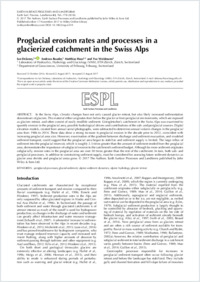Proglacial erosion rates and processes in a glacierized catchment in the Swiss Alps
- Delaney, Ian Laboratory of Hydraulics, Hydrology and Glaciology (VAW), ETH-Zürich, Switzerland
- Bauder, Andreas Laboratory of Hydraulics, Hydrology and Glaciology (VAW), ETH-Zürich, Switzerland
- Huss, Matthias Laboratory of Hydraulics, Hydrology and Glaciology (VAW), ETH-Zürich, Switzerland - Department of Geosciences, University of Fribourg, Switzerland
- Weidmann, Yvo Laboratory of Hydraulics, Hydrology and Glaciology (VAW), ETH-Zürich, Switzerland
-
17.11.2017
Published in:
- Earth Surface Processes and Landforms. - 2018, vol. 43, no. 4, p. 765–778
English
In the Swiss Alps, climatic changes have not only caused glacier retreat, but also likely increased sedimentation downstream of glaciers. This material either originates from below the glacier or from periglacial environments, which are exposed as glaciers retreat, and often consist of easily erodible sediment. Griesgletscher's catchment in the Swiss Alps was examined to quantify erosion in the proglacial area, possible hydrological drivers and contributions of the sub- and periglacial sources. Digital elevation models, created from annual aerial photographs, were subtracted to determine annual volume changes in the proglacial area from 1986 to 2014. These data show a strong increase in proglacial erosion in the decade prior to 2012, coincident with increasing proglacial area size. However, examination of the gradient between discharge and sediment evacuation, and modeled sediment transport, could suggest that the proglacial area began to stabilize and sediment supply is limited. The large influx of sediment into the proglacial reservoir, which is roughly 2.5 times greater than the amount of sediment eroded from the proglacial area, demonstrates the importance of subglacial erosion to the catchment's sediment budget. Although far more sediment originates subglacially, erosion rates in the proglacial area are over 50 times greater than the rest of the catchment. In turn, both sub- and periglacial processes, in addition to constraining sediment supply, must be considered for assessing future sediment dynamics as glacier area shrinks and proglacial areas grow.
- Faculty
- Faculté des sciences et de médecine
- Department
- Département de Géosciences
- Language
-
- English
- Classification
- Hydrology
- License
-
License undefined
- Identifiers
-
- RERO DOC 309493
- DOI 10.1002/esp.4239
- Persistent URL
- https://folia.unifr.ch/unifr/documents/306609
Statistics
Document views: 148
File downloads:
- pdf: 267
